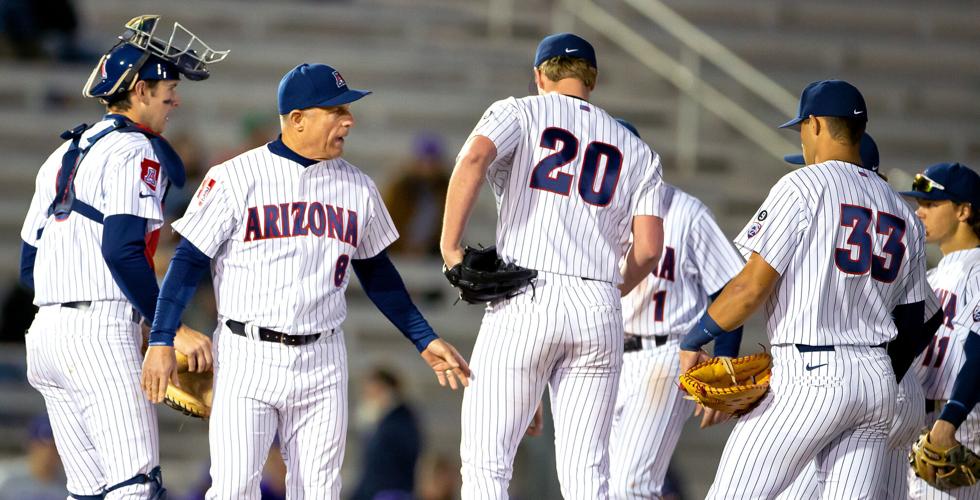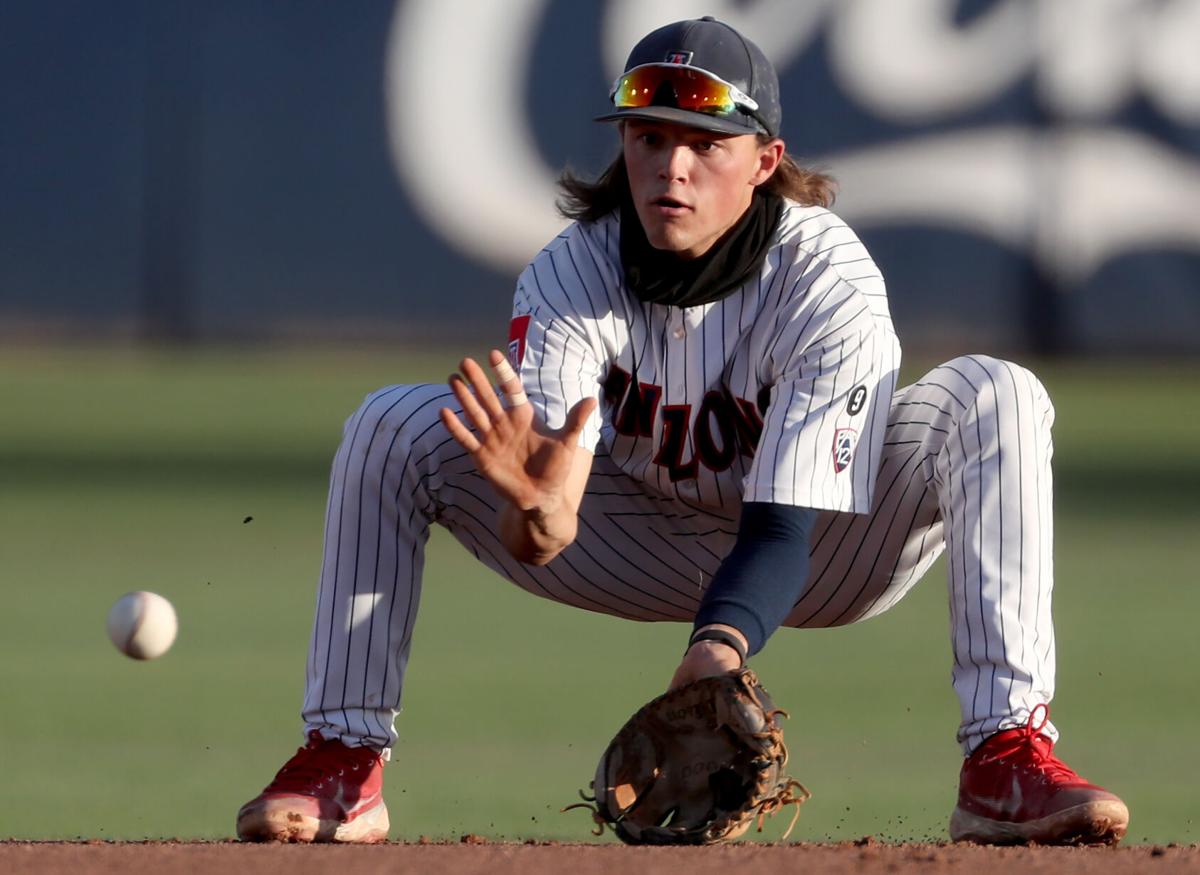Many college shortstops are bigger than Nik McClaughry. Many have put up bigger numbers. Many receive more acclaim.
Are any playing better than Arizona’s defensive leader and newfound leadoff man?
McClaughry, a fourth-year junior listed at 5 feet 9 inches and 165 pounds, has yet to commit an error. The Wildcats have played nine games. He’s had 41 chances.
McClaughry is batting .333 with a .395 on-base percentage — early indicators that his better-than-expected hitting from last season (.316/.412) wasn’t a fluke. Moving from the ninth spot in the order to first — theoretically a more pressure-packed role — hasn’t affected him a bit. McClaughry is batting .333 as the No. 9 hitter ... and .333 as the leadoff batter.
“He works really hard at it,” said UA coach Chip Hale, whose team begins a three-game series against Texas State on Friday at Hi Corbett Field. “And he takes what we give him from the scouting report. If the guy pitches away, he tries to shoot the ball into right. He can turn on the ball at times.
“Another guy that puts the ball in play. When he strikes out, it probably bothers him more than anybody.”
McClaughry has struck out six times. That’s tied for the fewest on the team among players who have started seven or more games.
Mac Bingham, who started the season in the leadoff position, has struggled to make consistent contact. He has a team-high 15 strikeouts in 34 at-bats.
What’s remarkable about McClaughry’s ascent to the top of the lineup is that he never hit this well in junior college. McClaughry batted .260 in 58 games at Sacramento City College. He did post a .391 on-base percentage, a sign that his strike-zone judgment was sound. McClaughry said he’s simply a more mature batter now.
“My mental approach at the plate has grown from junior college, where I learned a lot of stuff to help slow the game down,” he said. “Baseball is a game that can speed up on you. When you’re in the box, you don’t want it to speed up on you. If you can slow the game down in your own mind, then your ability will (surface).”
McClaughry always appears to play under control in the field. He gives much of the credit for his fielding prowess to Sac City infield coach Lynn Black.
“He focused on just catching the ball and throwing the ball,” McClaughry said. “It doesn’t have to look pretty. As long as you can catch it and get it over there to first base, that’s the most important thing.”
McClaughry has a knack for knowing just how much velocity to put on his throws — something some big-leaguers never get down, Hale said. McClaughry even factors in the skill sets of his first basemen.
McClaughry knew that last year’s first baseman, 6-1 Branden Boissiere, excelled at scooping balls out of the dirt. So if McClaughry had to make a rushed or off-balance throw, he could afford to miss low.
Current first baseman Noah Turley is every bit of 6-4. If McClaughry misses slightly high, he knows Turley will snag the ball.
As far as his own size goes, McClaughry embraces it. He lists 5-9 former Red Sox second baseman Dustin Pedroia as one of his favorite players.
“I kinda like it,” McClaughry said. “I can play with the best guys out there. You can be big like Dan Susac (Arizona’s 6-4 catcher) or you can be smaller like me — as long as you play hard. I take pride in playing hard.”

Arizona coach Chip Hale walks off the mound after talking with the Wildcats' pitcher and defense during the Wildcats' hope opener against Grand Canyon last week.
Ups and downs
As a team, Arizona is striking out more than it did last year.
The Wildcats are averaging 10.33 strikeouts per game. Their K rate (strikeouts per plate appearance) is 24.2%.
In 2021 — with a different lineup and a different coaching staff — those figures were 7.95 and 18.3%.
“We did a lot of ‘Two-Strike Tuesdays’ in the fall. We’re gonna do a little ‘Two-strike Wednesday’ today,” Hale said during his media availability Wednesday.
“A lot of times, it’s just about recognizing strikes. It’d be one thing if we’re swinging through balls that are in the zone. But we’re really swinging at a lot of pitches that are not hittable.
“Guys are learning. It gets rough at times. But you’ve got to give them a little rope.”
Hale was encouraged by how Tuesday’s game against Dixie State ended. Chase Davis, who has struck out 13 times this season, drew a bases-loaded, walk-off walk in the 10th inning after falling behind in the count 1-2.
Speaking of walks, Arizona’s pitching staff isn’t issuing as many of them. The Wildcats’ BB/9 rate is 2.96, which ranks fourth in the Pac-12 and 33rd nationally. It’s down from 3.90 last year and is a number that continues to fall since the struggles of 2019 (5.33).
Strike-throwing was one of Hale’s biggest concerns entering the season. It hasn’t been an issue so far.
“It’s been great,” Hale said. “I’m excited about that. If you remember, in the fall ... and then starting the spring, we were having a hard time facing our own hitters. We were walking way too many guys.”
‘Very difficult’
Hale knows what it’s like to endure a work stoppage like the one MLB is facing.
Hale was a fourth-year pro with the Minnesota Twins when the players went on strike in 1994. The second half of the season was wiped out, and the World Series wasn’t played for the first time in 90 years.
Hale was 29 at the time. He and wife Judi had one child, and she was pregnant with another. Hale played winter ball in Venezuela to help make ends meet.
“It was very difficult,” Hale said. “You have to pay bills. But you have to realize what’s gone on in the past and what your predecessors have gone through to give you the opportunity with pension and minimum salary and all the different things as a young player you love.
“So sometimes you have to just suck it up, and I did. I went to winter ball to make money.”
Inside pitch
Hale said third baseman Tony Bullard and right-hander Chandler Murphy could return next week. Bullard, who has yet to play because of a shoulder injury, has been taking swings and could serve as a DH. Murphy, who’s been battling an arm issue, had another positive bullpen session this week. He likely would start out in relief.
No. 13 Arizona will use the same rotation as the first two weekends: right-hander TJ Nichols (1-0, 1.80 ERA) followed by left-hander Garrett Irvin (1-0, 1.80) and righty Dawson Netz (1-90, 2.16). Texas State (8-1) will throw a trio of righties at the Wildcats. Friday starter Zeke Wood has allowed only two hits in 13 innings while striking out 22 batters.
After pitching five shutout innings vs. Dixie State, UA righty Quinn Flanagan lowered his ERA from 7.71 to 2.45. He has a 13-0 K/BB ratio.
Arizona’s offense ranks among the top three in the Pac-12 in hits, doubles, triples, runs, batting average and slugging percentage.






